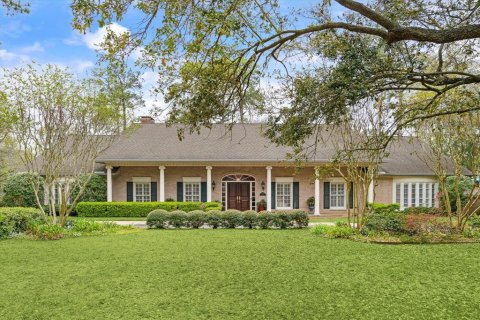Houston and Dallas Live Theater Companies Turn to Filmed Shows — a Grand Experiment Amid the Devastation of Forced Coronavirus Shutterings?
Even as the Alley Theatre Cancels its Entire Season and Dallas Theatre Center Regroups, They Try to Find (and Offer) Future Hope
BY Tarra Gaines // 03.23.20Scenes from the Alley Theatre's production of 1984 to be viewed in subscribers' homes via password protected link. (Photo by Lynn Lane)
All across America as performance spaces have gone dark, performing companies and theaters have begun searching for ways to continue to bring some much needed art into our lives. In Texas, two Tony Award winning theater companies, the Alley Theatre and Dallas Theatre Center, are trying a rare experiment for United States live theater companies, releasing filmed performances for viewers to stream at home.
Dallas Theatre Center had not yet opened its new musical American Mariachi before theaters throughout Dallas had to close. Luckily, they make it a practice to record dress rehearsals for archival purposes. Knowing the theater might have to shutter soon, they brought in four high-res cameras and used state-of-the-art sound recording this time to film this emotional musical comedy about a 1970s all-girl all-girl mariachi band. If audiences could not come to DTC, perhaps this Mariachi band could bring the music home.
The Alley had only just opened their production of George Orwell’s classic dystopian drama 1984, when they were forced to close the next day. Alley artistic director, Rob Melrose, who also directed 1984, tells PaperCity that by the next day they were already exploring the idea to film a performance in the empty Hubbard theater for at-home audiences.
Live Performances Later
While the New York Metropolitan Opera and London’s National Theatre (NTLive) have been filming productions and screening performances in movie theaters for years, New York and regional theater companies have seldom offered those kind of opportunities to see a live performance without actually being in there.
Of course, one of the reasons for the rarity remains the thrill of experiences a live performance in person, especially since it will never be exactly the same performance twice. But the rules of some of the artists unions also prevent it.
During this crisis, Melrose says everyone got on board when the Alley called.
“The unions were really terrific and understood the gravity of the situation,” he notes. “They responded really quickly. Obviously they want their members working and they want the theaters to survive. They were very responsive.”
While it’s never been done completely at the Alley, Melrose has actually directed a filming of a live production a few times, once for a production of Frankenstein and another for a marathon of Strindberg chamber plays he did at Cutting Ball, the theater he co-founded in San Fransisco. In that case, he had requests from educational institutes and universities to document the seldom produced plays. Strindberg fans can watch them at home even today.
An NFL Model?
In our talk, Melrose makes what at first seems a strange and unique comparison for filming a live theatrical performance, the broadcast of any football game. He explains that Brandon Kahn, Alley general manager actually wrote his graduate thesis on initial resistance when the NFL first started broadcasting games. Many thought ticket sales for games would go down.
“All these years later, we see it just raised awareness, and it got people more excited about football,” Melrose says. “You can see that happening with opera and NTLive, but especially opera. We didn’t have young people thinking it was something they’d want to go to, but now it’s so available.”
Melrose believe the Met’s recent decision to stream previous productions will only broaden opera’s appeal.
“While they’re in this shutdown, they’re offering on their website every night at seven one of their many productions they filmed,” he says. “They have an archive of great filming of their work. They’re able to survive this shutdown because they have all this great material.”
Performance vs. Movie
Whether it be Met broadcasts, NTLive, his direction of Frankenstein or a Sunday NFL game, Melrose asserts recording a live production is not really like making a film.
“It’s a documentation of a live event. Of course you’re making artistic decisions about should we go wide here should we go tight here, but you’re not cutting it together like a film. You’re cutting it together as a live event.”
Those artistic decisions come because recording a live performance takes more than just placing a camera at the back of the house. For 1984, they set up three cameras in the Hubbard house to capture different angles and closeups on the actors, while allowing for wider shots of the whole stage. This will enable home viewers to get a closer look at the actors while also feeling like they’re sitting right there in the Hubbard space.
The cast rehearsed on Monday, with Melrose making a few tweaks to the production for cameras and then filmed on Tuesday. He gives great praise to videographer on the project, John Carrithers.
“He’s done the best job of anyone I’ve ever worked with at capturing what the staging looks like,” Melrose says. “He’s able to get in close enough that you feel like you’re with the actors but he bounces back to the medium shot often enough that you get a sense of what it’s like in the theater. I think it’s going to be pretty wonderful.”
In a statement about the decision to allow home viewing for American Mariachi, DTC artistic director Kevin Moriarty professes hope that the production brings hope to theater-goers.
“Bringing people together through art is an important part of healing,” Moriarty’s statement reads. “We hope that some of the heart and soul of that live experience will come through your screen and provide you with a moment of joy.”
Limited Time to See
Both the 1984 and American Mariachi filmed production will resemble attending a live performance in one other way. Viewers will have a limited time to see the productions. The 1984 screening will be available for about two weeks, while tickets for Mariachi will be sold up to the end of the original run. Once a ticket is purchased viewers have two weeks to screen it.

Both theaters can only sell as many virtual tickets as there would be seats for the entire run of the show. Those patron and subscribers who already purchased a ticket for 1984 will get notification of how to stream the performance on the Alley website. Meanwhile anyone, no matter where they are social distancing can purchase a ticket to see either performance.
“Who knows what’s going to get us out of the coronavirus crisis, but maybe, maybe videotaping performances having the unions be a little looser or at least rethink these technologies it could be a good thing for the future,” Melrose says.
Soon after PaperCity spoke with Melrose, the Alley announced it would have to cancel the rest of the season and were forced to layoff the majority of their staff. But this one show, 1984, will go on giving Houston theater-lovers a taste of the excitement of live theater. Perhaps this production about a very dark future will also paradoxically do its bit to keep performing arts alive while we wait for a brighter future, returning to our favorite theaters across the city and across the nation.
“We know that when the coronavirus crisis is over that our city will be eager to come together in shared celebrations of our common humanity,” Moriarty says. “We are eager to welcome the return of communal life when that day comes, with theater being at the heart of our shared experience.”
































_md.jpeg)

_md.jpeg)



_md.jpeg)

_md.jpeg)


